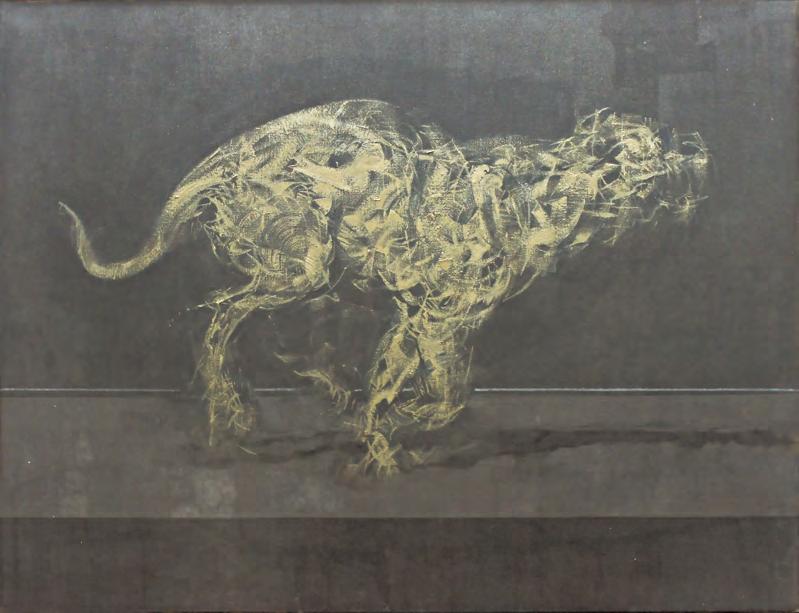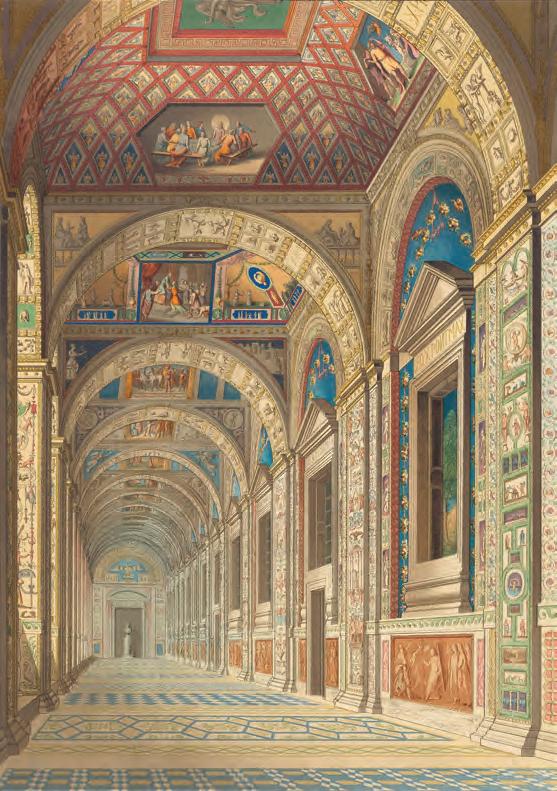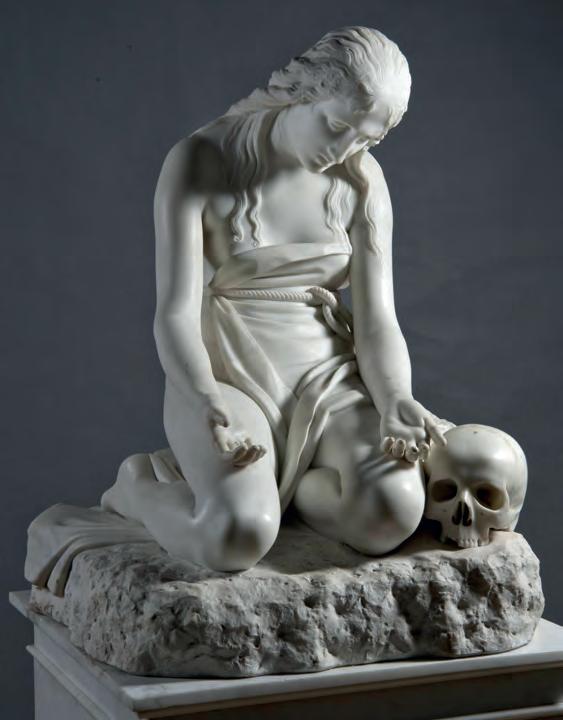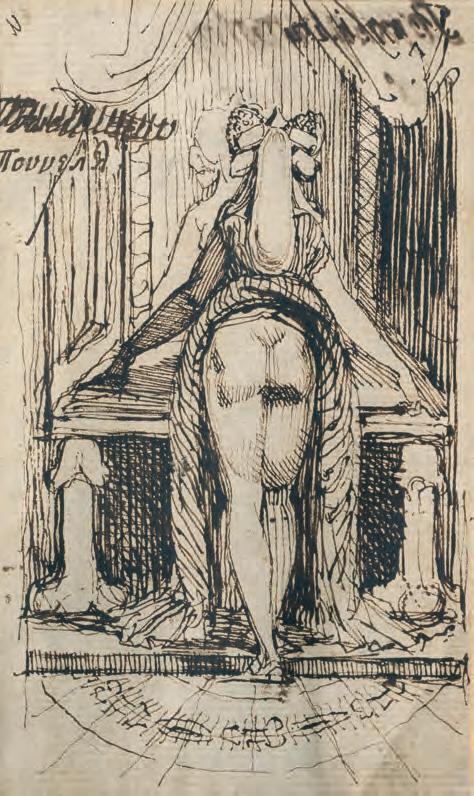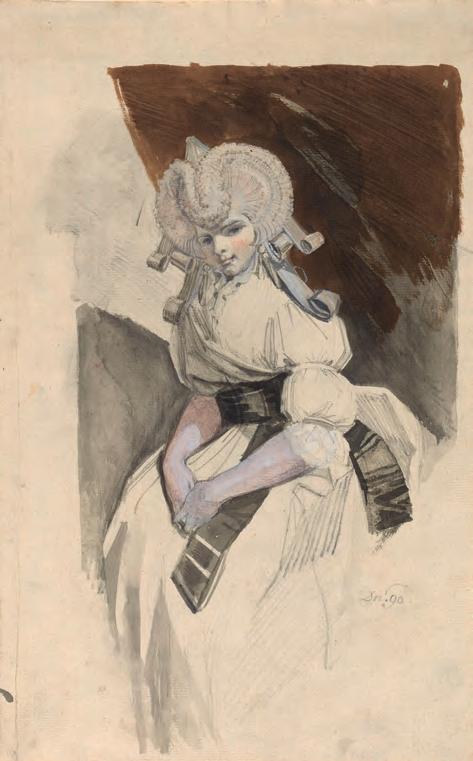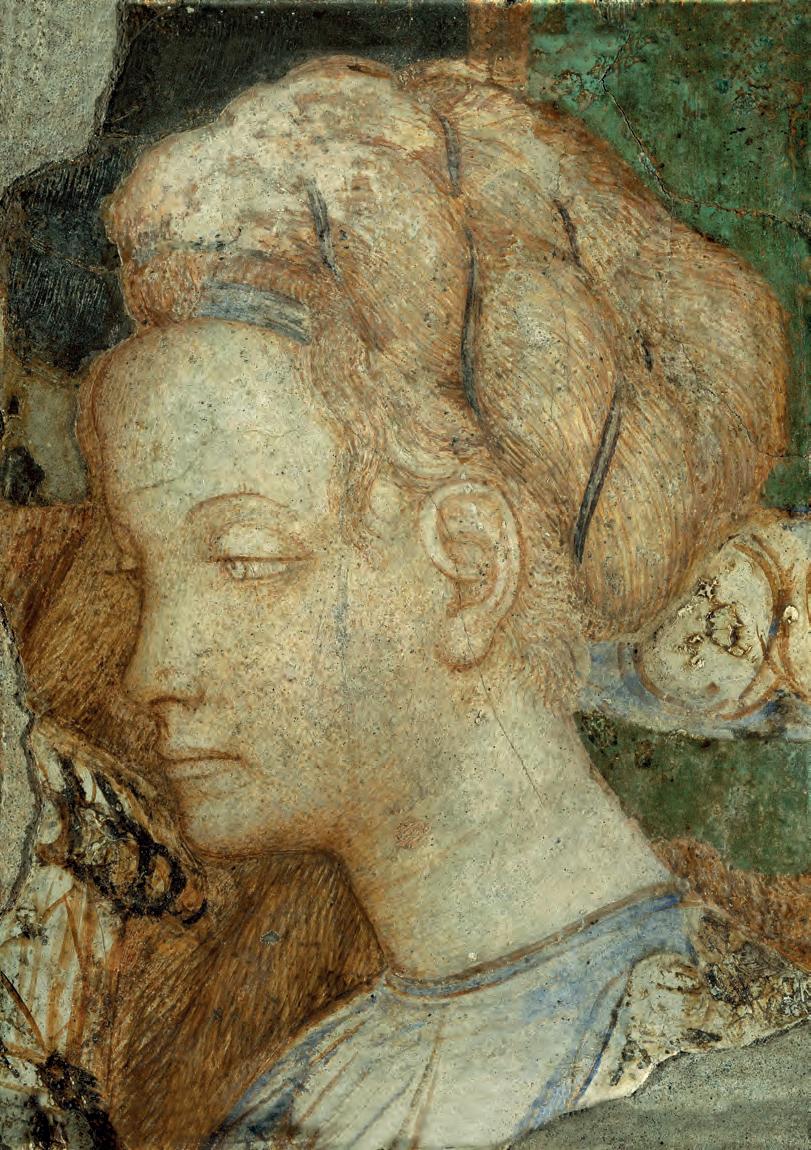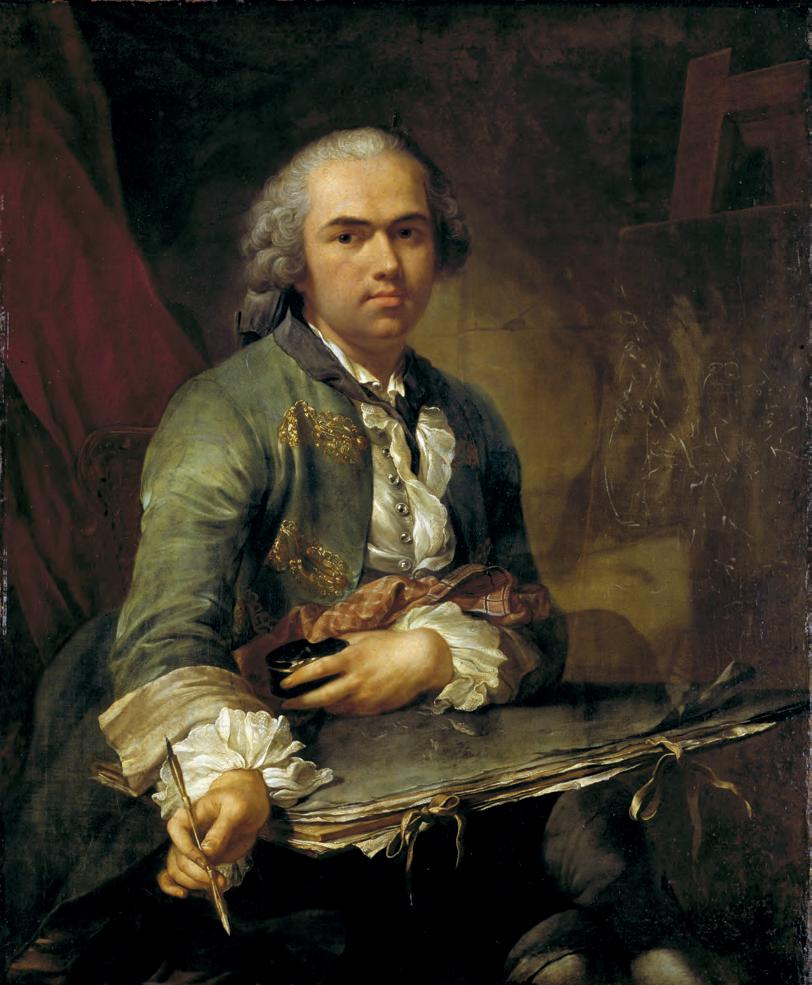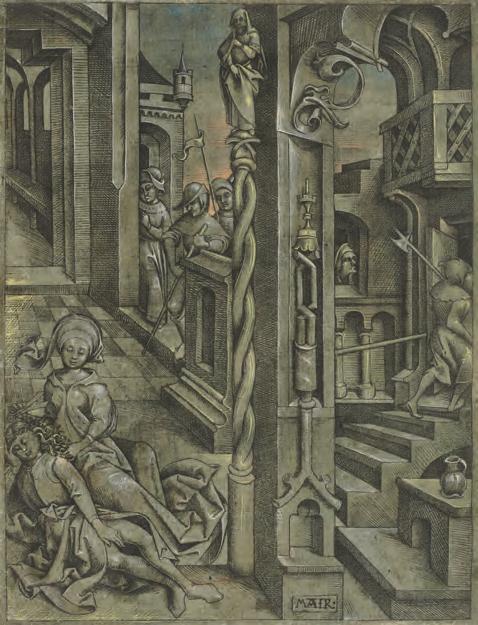
7 minute read
On Bramante, P.P. Tamburelli
Opposite 5. A bishop’s crozier, by Israhel van Meckenem. c.1485–95. Engraving, 78.8 by 23 cm. (Städel Museum, Frankfurt). 6. Judgement of Solomon, by Master BM. c.1480–1500. Engraving, 29.4 by 42.1 cm. (Städel Museum, Frankfurt). argues that this distinction is flawed since the use of models and templates was always an essential element of late-medieval workshop practice. Although reconstructing the transmission of motifs is unquestionably important, it is also necessary to look into the ways such appropriations are used by artists and to define the innovative elements that can be found within every process of copying. This allows a re-evaluation of the technical bravura of works that have too often been relegated to the merely imitative or reproductive.
Accordingly, throughout the exhibition and catalogue all artists are described as ‘masters’. Furthermore, equal space is given to Martin Schongauer and Israhel van Meckenem (c.1440/45–1503), whom Lehrs had considered as a ‘meagre copyist’.4 The prints by these two artists occupy corresponding sections on each side of the main gallery space. Visitors can thus examine the ways in which Van Meckenem adopted Schongauer’s motifs and, in many cases, attempted to outdo his rival. Schongauer’s depiction of the top of a bishop’s crozier, for example, measures 28.6 by 12.8 centimetres (no.57). In Van Meckenem’s version, the subject has been expanded and turned into an example of elaborate micro-architecture, printed from two plates on two sheets, so that its overall height amounts to 78.8 centimetres (no.101; Fig.5). Van Meckenem also adopted the composition of Schongauer’s Large Crucifixion (cat. fig.66), but set the scene against a dark background, created by an elaborately engraved web of dense crosshatching (no.86). As Sonnabend argues in the catalogue, this demonstrates the technical prowess of Van Meckenem, who was able to create subtle values within the picture plane that appear painterly but nonetheless never deny the metallic character of their engraved source. Towards the end of the exhibition, one is reminded of the important transitional role occupied by Van Meckenem, who emulated the creations of his contemporaries as well as of earlier masters, but also lived long enough to take note of the work of Dürer, who was a generation younger. When copying Dürer’s mysterious print Four nude women (1496; no.117), Van Meckenem showed off his mastery of the burin by rendering subtle passages of shading that are notably different from Dürer’s more linear handling of forms (cat. fig.84); and whereas Dürer thought it sufficient to inscribe his trademark monogram on the print, Van Meckenem signed the plate prominently below the image with his name and origin – ‘Israhel V.M. tzu boeckholt’ (‘Israhel van Meckenem from Bocholt’) – thereby proudly and confidently advertising his authorship.
Advertisement
Having opened the exhibition with Dürer’s Adam and Eve, Sonnabend closes it with further examples of Dürer’s printmaking up to 1504. The new technique of creating and multiplying images fixed on sheets of paper had now established itself as an autonomous artistic medium. This new art form could be used for the recording of motifs, patterns and pictorial inventions in model books, a task for which drawing had previously been used. Drawing was thus slowly liberated and could be used to capture ideas and to play freely with the possibilities offered by the light touch of the pen on paper – as demonstrated by the delicacy of the linework in the sole drawing that Sonnabend could clearly not resist including. Woman holding a flowery branch (c.1470–80; cat. fig.8) is a pen and ink drawing that has often been attributed to Master ES but is described here more cautiously as the work of an anonymous artist from the Upper Rhine valley. Exploring this process of emancipation further, however, would have needed to be the subject of another exhibition.5
1 M. Lehrs: ‘Der deutsche und niederländische Kupferstich des fünfzehnten Jahrhunderts in den kleineren Sammlungen’, Repertorium für Kunstwissenschaft 14 (1891), pp.384–409, at p.384 (emphasis in the original); Lehrs incorporated this survey into his fundamental Geschichte und kritischer Katalog des deutschen, niederländischen und französischen Kupferstichs im XV. Jahrhundert, Vienna 1908–34. 2 Lehrs 1891, op. cit. (note 10), p.384. 3 Catalogue: Vor Dürer. Kupferstich wird Kunst: Deutsche und niederländische Kupferstiche des 15. Jahrhunderts aus der Graphischen Sammlung des Städel Museums. By Martin Sonnabend. 312 pp. incl. 221 col. ills. (Sandstein Verlag, Dresden, 2022), €49.90. ISBN 978–3–95498–707–8. 4 M. Lehrs: Der Meister mit den Bandrollen: Ein Beitrag zur Geschichte des ältesten Kupferstiches in Deutschland, Dresden 1886, p.31. 5 For the Städel’s collection, this was examined by S. Buck: exh. cat. Wendepunkte deutscher Zeichenkunst: Spätgotik und Renaissance im Städel, Frankfurt 2003–04. Still useful as a concise general overview of the development of drawings from model sheet to free sketch is U. Jenni: ‘Vom mittelalterlichen Musterbuch zum Skizzenbuch der Neuzeit’, in A. Legner, ed.: exh. cat. Die Parler und der schöne Stil 1350–1400: europäische Kunst unter den Luxemburgern. Ein Handbuch zur Ausstellung des Schnütgen-Museums in der Kunsthalle Köln, Cologne (Museen der Stadt Köln) 1978, III, pp.139–41.
Pisanello: Il Tumulto del Mondo
Palazzo Ducale, Mantua 7th October 2022–8th January 2023
by samuel dawson
At a press conference on 26th February 1969, Giovanni Paccagnini, the Superintendent of Fine Arts of Mantua, announced a discovery of some magnitude. Beneath several layers of plaster in a room on the piano nobile of the ducal palace, Paccagnini had revealed the remains of a vast Arthurian mural cycle by the celebrated fifteenth-century artist Antonio di Pucci, better known as Pisanello (c.1394–c.1455). The discovery was remarkable for several reasons. A major work, covering over three hundred square metres, the cycle is one of only three surviving murals by Pisanello. The other two, both in Verona, are an Annunciation (c.1426) flanking the upper parts of the Brenzoni monument in S. Fermo Maggiore and St George and the princess (c.1436) in the Pellegrini chapel of S. Anastasia. The Mantua fresco cycle is the only extant example of a work designed for a court setting by the artist, who was regarded by his contemporaries as the principal court artist of his time. Given the significance of the find, it was understandable that Paccagnini believed that Pisanello’s chivalric cycle was ‘destined to become [. . .] a new focus of cultural interest for Palazzo Ducale, no less important than the well-known Camera degli Sposi by Mantegna’.1
The frescos, which occupy the four walls of the rectangular Sala del Pisanello, as the hall was already called in an early document, were unveiled in the exhibition Pisanello alla corte dei Gonzaga, organised by Paccagnini in 1972.2 Fifty years later the present exhibition at Palazzo Ducale pays tribute to Paccagnini’s achievement while conceding that Pisanello’s cycle has not quite achieved the status and aroused the public interest that he anticipated. As the director and lead exhibition curator, Stefano L’Occaso, laments in the introduction to the catalogue, ‘if not invited by a guide, visitors tended to pass by [Pisanello’s] paintings, content with a distracted glance at the works, which were distant [from the viewer] and difficult to understand’ (p.7).3 Several factors contributed to this lack of popular appeal. The subject of the cycle is obscure, drawn from a marginal episode in the Lancelot du Lac, and the cycle is unfinished, since Pisanello abandoned the work midway through painting it, leaving for some sections only the sinopie completed. This has resulted in a stylistic unevenness that is exacerbated by the extensive damage suffered by the paintings. For example, it is hard to comprehend the narrative of the fragment of the great tournament scene on the southeast wall (Fig.7). It combines parts painted in buon fresco and parts a secco, as well as sections in glazed metal leaf and in pastiglia and areas moulded in relief for the insertion of precious jewels (petre contrafacte). In contrast, on the adjacent northeast wall, a highly detailed ‘quasi-sinopia’ in red chalk is likely to have been conceived as a temporary substitute rather than a cursory preparatory sketch that was intended to be finished later.
During a renovation in 2022 of the Sala del Pisanello the height of the floor was raised by over a metre, so that it is now at the level of the fifteenth century floor, and new lighting was installed. As L’Occaso explains in his informative catalogue essay on the room’s original architectural layout, this approach is not only historically accurate but also intended to create an immersive experience. By reducing the distance between the spectator and the mural cycle, visitors can examine the frescos in greater detail and, simultaneously, project themselves into the painting and onto the tournament field. It is now possible, for instance, to observe the artist’s ingenuity in painting one part of a tournament knight on the
7. Sala del Pisanello, Palazzo Ducale, Mantua. (Courtesy Palazzo Ducale, Mantua; photograph Vincenzo Bruno).

WHAT’S ON
Our online Calendar is the best guide to exhibitions around the world.
VISIT
burlington.org.uk/whats-on

